A brief tour through Taiwan’s favorite texture.
Each morning in Taipei, I make my way to a neighborhood coffee shop called The Folks, owned by a soft-spoken and gracious man named Tzuchi. I stumbled across his shop more than a year ago while wandering side streets. From my first sip of his espresso, I pegged Tzuchi as someone with a very refined palate. Over time, he has patiently steered me toward restaurants, food, and drink throughout Taiwan. His amusement is palpable, however, when I began to quiz him on Q.
At the heart of most culinary endeavors is flavor. We look for a balance of salty and sweet, a gentle spike of acidity, maybe some chili-induced fire on the tongue. In Taiwanese cooking, however, taste often plays second fiddle to a curiosity known as “Q”.
Q is a springy, chewy texture. Most typically pronounced simply as the English letter “Q”, or the cutesier form “QQ”, some also say tan ya, which brilliantly translates as “rebound teeth.” But it’s not just a texture; it’s a cornerstone of Taiwanese cooking so revered it appears repeatedly throughout the day in dishes both sweet and savory, hot and cold, and even in drinks. I’m told that Q is actually derived from the Taiwanese Hokkien word k’iu, and and that there isn’t a Chinese character for the pronunciation, although it’s hard to track down much information on the word’s origins. While neighboring cuisines, Chinese and Japanese in particular, have a strong affection for this chewy texture—think mochi, fish cakes, and many dumplings—they don’t refer to it in the same way.
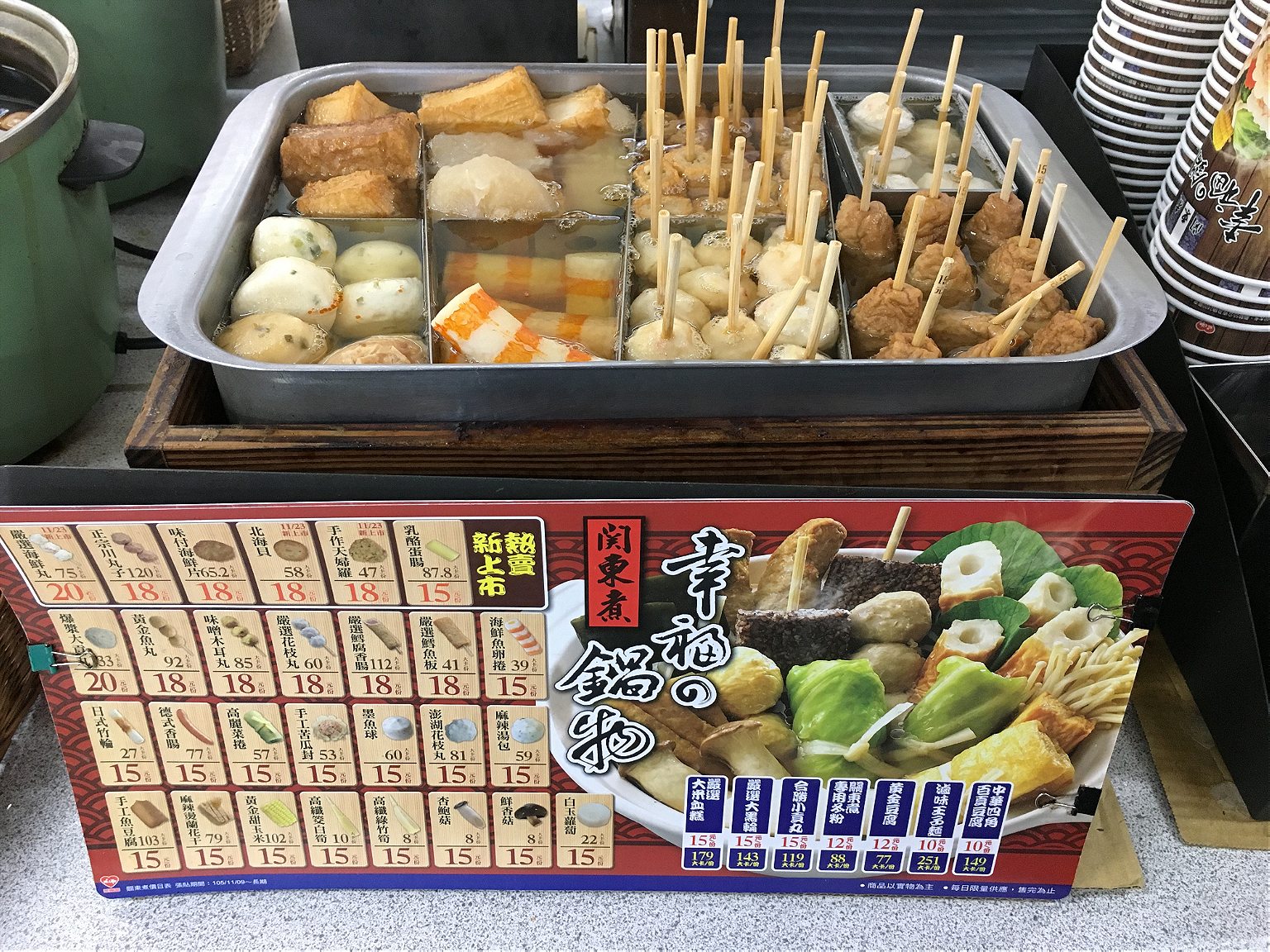
The mouth feel of a gummy worm would be the lowest form of Q. Now, imagine how exponentially more interesting that texture becomes in the form of har gow, or crystal dumplings, little sachets of filling given a layer of Q thanks to tapioca in the wrapper. Or Taiwanese pork meatballs, sometimes called bouncy meatballs, entirely different from their tender Italian counterparts: a gently seasoned paste of ice-cold pork, pounded together with a starch and rolled into pale rounds. The meatballs look like silly putty, and have nearly as much bounce. Some might call their texture rubbery, but in the most addictive way.
I initially didn’t understand how an entire nation could hold a texture in such high regard. My own initial reaction to Q was definitely not love at first sight. Even approachable boba pearls, the playfully slippery, resistant orbs of tapioca found at the bottom of sweet bubble tea, felt wrong at first, a creepy surprise jetting from the end of a comically fat straw. But as I grew to understand the true significance of Q, my attitude toward the sensation transformed. Identifying its common thread as a starchy element—usually glutinous rice flour, sweet-potato starch, or tapioca—that provides its telltale chewiness, I found myself enamored of warm, savory examples of Q, like meatballs and fish balls, crystal dumplings, and steamed sticky-rice cakes. I grew to seek out Q like a favored friend, pining for the texture itself rather than looking to satisfy flavor expectations.
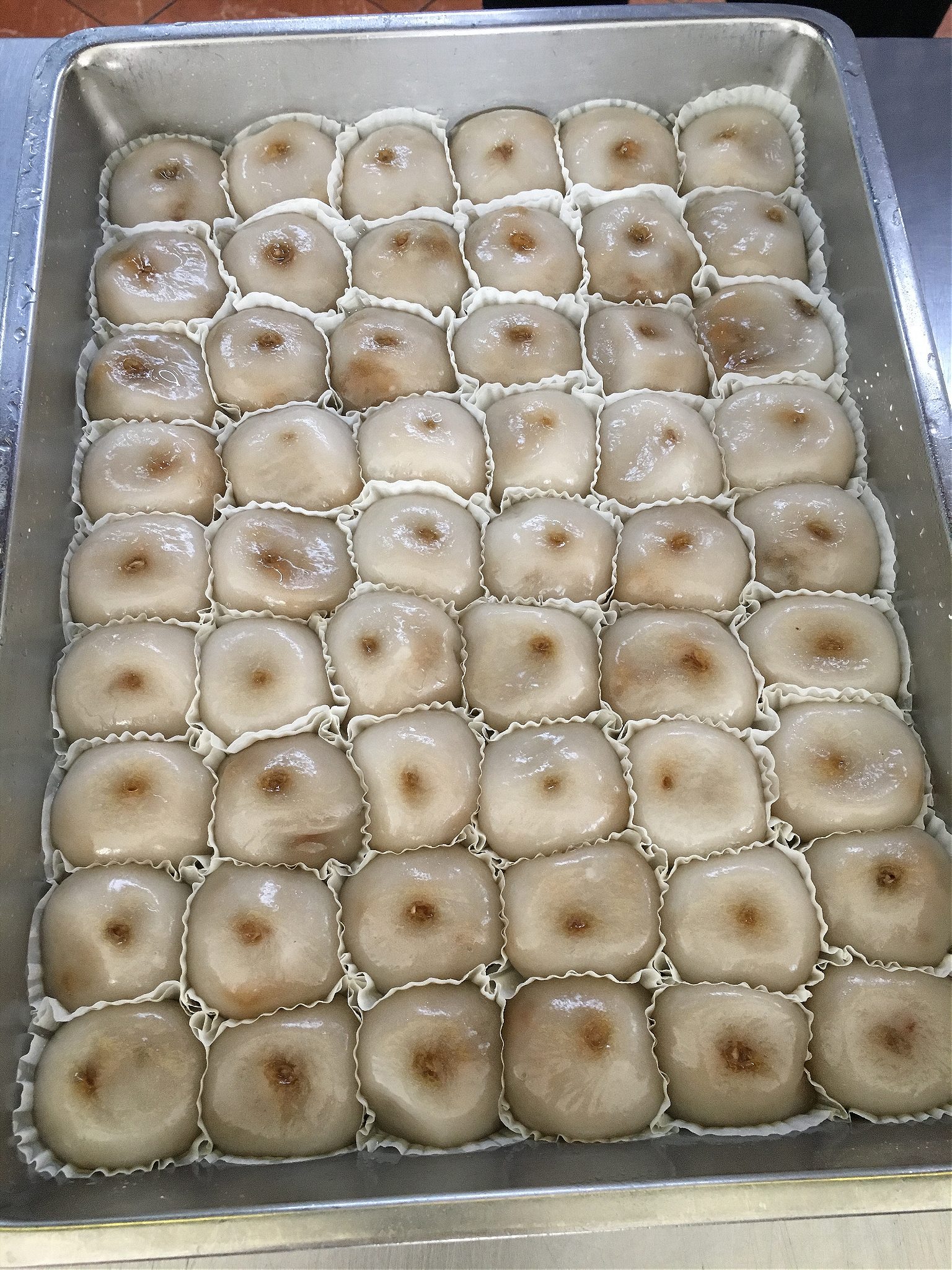
In Taipei, the quest for Q is not a challenge. Bubble-tea shops sit on nearly every corner, and even Family Mart—the ubiquitous Taiwanese convenience store—proudly displays a selection of “Q-on-a-stick”, skewered bits of fish cakes and meatballs, ready to pluck from a tray of water, front-and-center, like the hot dog stand at any mini-mart in Middle America. But why settle for easy access? I am on a Q mission.
The Q Quest Begins
Tzuchi agrees to take me to one of his favorite local spots for bawan, a large meatball encased in a springy, chewy wrapper. Like many things Q, bawan is a matter of deep personal preference, and Tzuchi’s heart belongs to the bawan of his hometown, Tainan. We stroll across the street to the public market, where he assures me the bawan from one particular stand is also top notch. We approach the vendor, who acknowledges us with a quick glance. She fishes what looks like a squishy bun from a wok filled with barely simmering oil and places the bawan in a small bowl, tilting it back over the wok to drain away the excess liquid. She then grabs a pair of shears and snips the bawan into pieces, making tackling the chewy exterior a little easier.
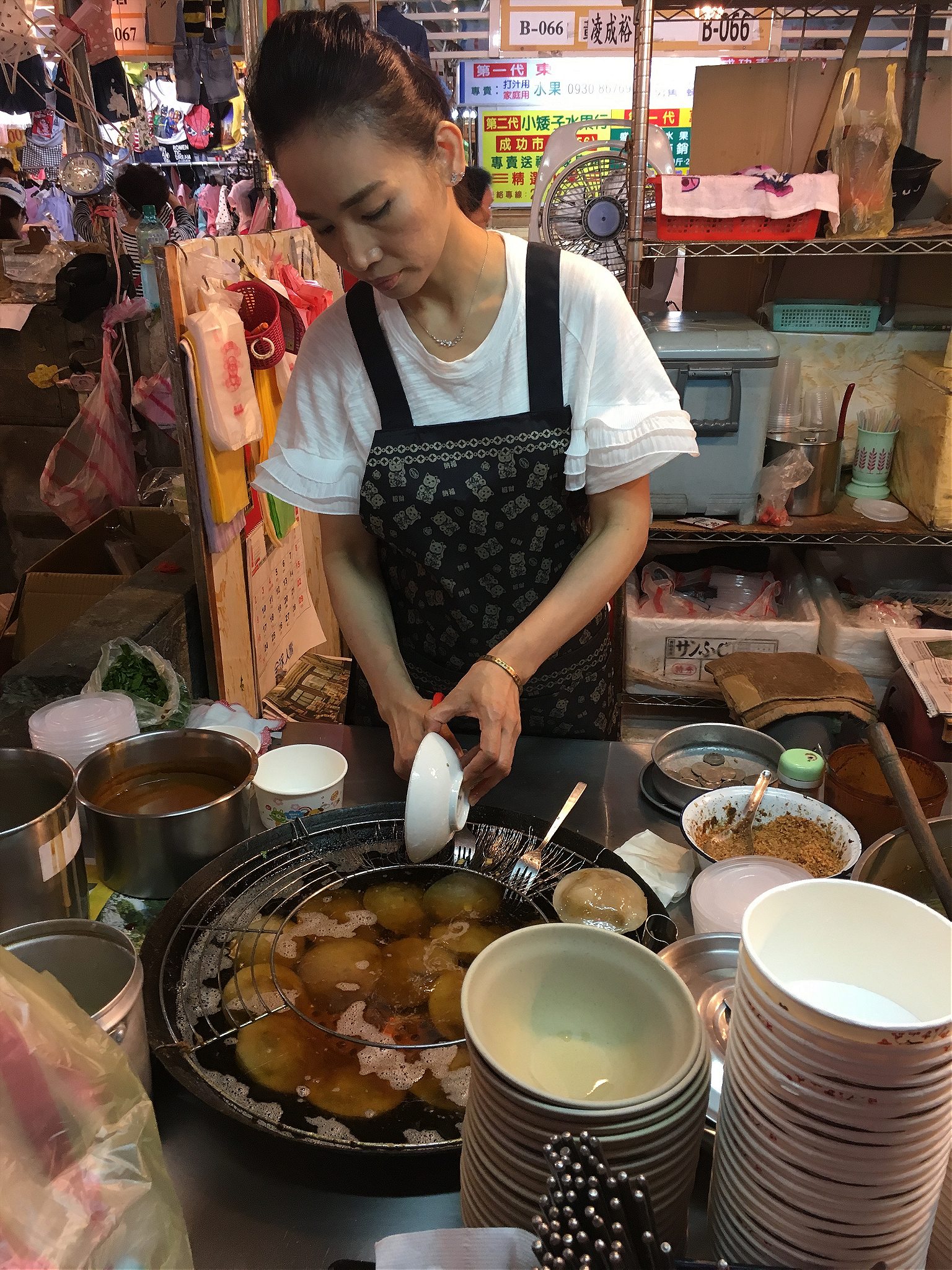
That chewiness, the source of bawan’s Q, comes from dough made of sweet-potato starch, rice flour, and water, and surrounds a pork, mushroom, and bamboo-shoot filling. The bawan are steamed, followed by gentle oil poaching, or, depending on the region, sometimes fried at a higher temperature for a crisp crust. I love the bawan itself, essentially a shapeless blob of mochi-covered meat. The oil-poached version is soft and yielding, topped with a thick, sweet, gravy-like sauce, likely a nod to the sweeter cuisines of southern Taiwan. It’s an interesting touch, but I can’t help but think how much I’d enjoy the bawan unadorned, or maybe with a splash of soy sauce, celebrating its simplicity.
An Iconic Dish
On the outskirts of the Tonghua night market, a busy couple runs a nondescript corner noodle shop, working together for twelve hours a day in perfect synch. Prep work, taking orders, bussing tables: each task belongs solely to them. The calmness of the service belies the non-stop hustle that delivers it.
The specialty here is Beef Noodle Soup, an iconic dish in Taiwan. I settle in at the counter and, with the assistance of a fellow customer, set about crafting the perfect bowl.
Start with the beef broth. Here it is surprisingly clear, yet flavorful and full of body. The clarity of this broth sets it apart; most are murkier, delicious in a different way. Next, I choose my noodle. Near the stove lay perfect mounds of noodles, thick or thin. I take the coward’s route and go with one bowl of each. A quick dunk of the noodles in the swirling vat of boiling water allows time for perhaps my most serious decision: choosing the beef. But no drama here or drawn out thought. As any aficionado of Q knows, the only choice is tendon. My newfound friend grins at the decisiveness of my response, translates my order for me, and then goes on his way.
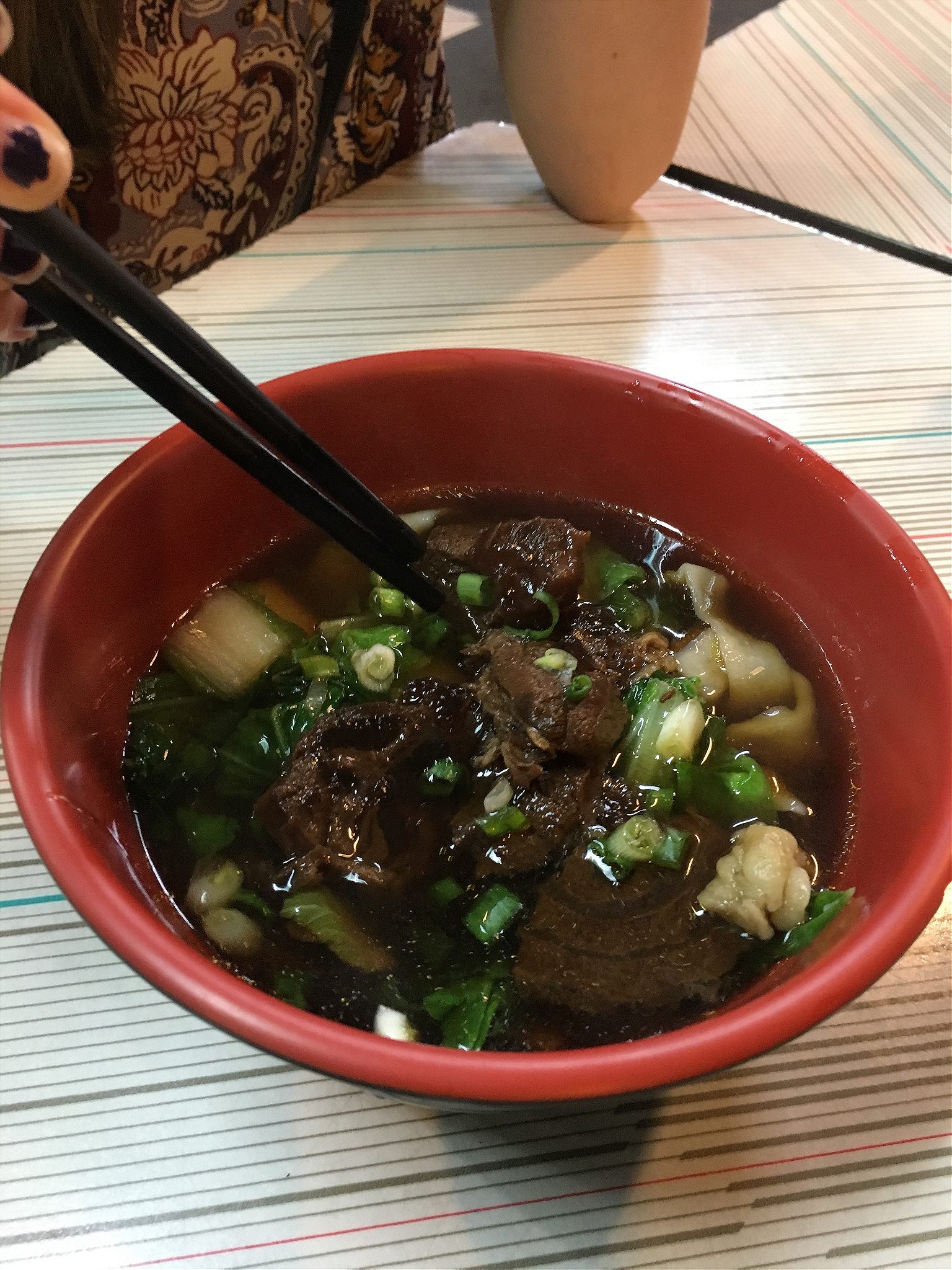
Unlike most Q foods, which rely on an addition of starch for their consistency, beef tendon is uniquely Q by nature. An example of pure texture at its finest, beef tendon requires a bit of back-and-forth tugging to rip that first bite from the chopsticks. Once it hits your mouth, however, your efforts are rewarded through the discovery of gelatinous pockets of collagen, interspersed within the ropy tendon, that reveal themselves by slowly by melting over your tongue. There’s little else in the bowl to distract from the simplicity of the broth, the noodles, and the tendon—a mere leaf or two of bok choy and a smattering of scallions. The owners leave a jar of chili oil and a crock of pickled mustard greens on the table just in case, but I sense they know perfection has already been reached.
Q of the Sea
After consuming a steady diet of Q for the better part of a month, I start craving crunch. A tiny plate of cucumber salad catches my eye, gleaming in a cooler case outside a bustling restaurant near Dihua Street. Stacked bins line the sidewalk, filled with thousands of perfectly rolled spheres of the house specialty, Fuzhou-style fish balls. I grab the cukes, and then head inside.
Fish balls are a common and beloved source of Q in Taipei. Made from white fish pounded into a smooth paste and combined with ice water and sweet-potato starch or tapioca for Q-iness, the resulting fish balls are poached in broth or sometimes deep-fried as “Taiwanese tempura.” The Fuzhou-style balls, closer in size to a ping-pong ball than the usual smaller size, hold a special surprise.
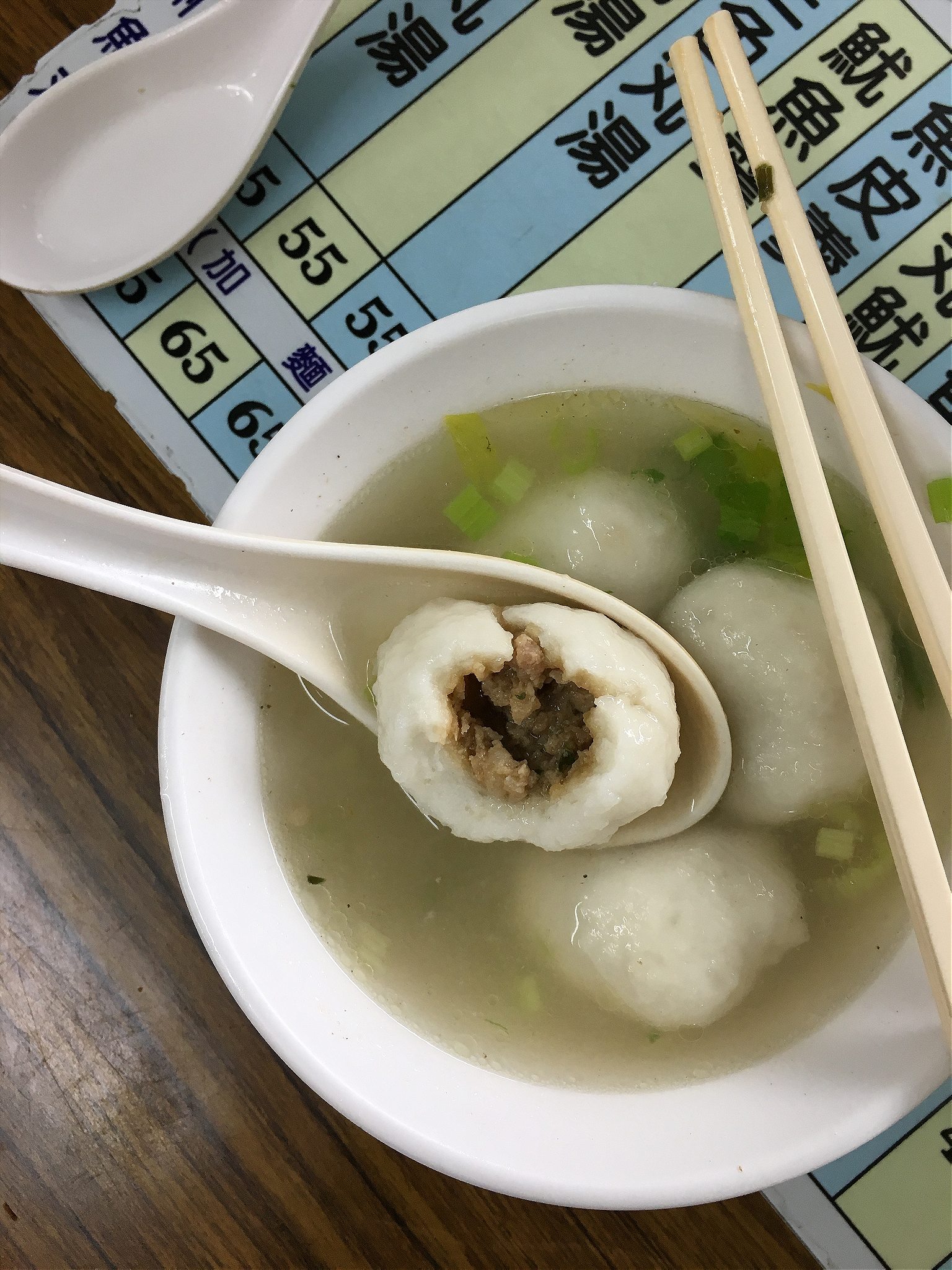
The line moves fast and efficiently with no time for indecision. I use the “point and nod” method of ordering, and pick up a small and simple bowl of soup. The fish balls, floating in a clear broth that tastes of celery leaves, look familiar, but one bite reveals a heavenly stuffing of pork and shallot. I close my eyes and appreciate the sensation as the textures unfold in my mouth, tender yet bouncy fish ball against crumbly pork, seemingly contradictory yet joining together as one of my all-time favorite bites of food. I also sense a flavor difference from other fish balls I’ve tasted. Could there be lard in the fish paste? My efforts to ascertain the answer are immediately shot down by the suspicious staff. Perhaps they think I’m a recipe thief.
The Sweetest Q
Lest there be any notion that Q ends with dinner, rest assured, there’s plenty of sweet Q to be had for those with a sweet tooth. The hunt for dessert Q begins with a friend of mine, local food expert Tina Fong, who guides me to a lively shaved ice shop called Longdu in the Wanhua district, founded nearly a century ago in 1920.
I peer through the glass at a stunning spectrum of potential toppings, everything from barley to fresh mango, mung beans, peanuts, and more. But the mission at hand precludes picking favorites, so Tina confidently orders “all the Q.” A masked worker hands me a mountain of freshly shaved ice, topped with four entirely different types of Q. Mind blown.
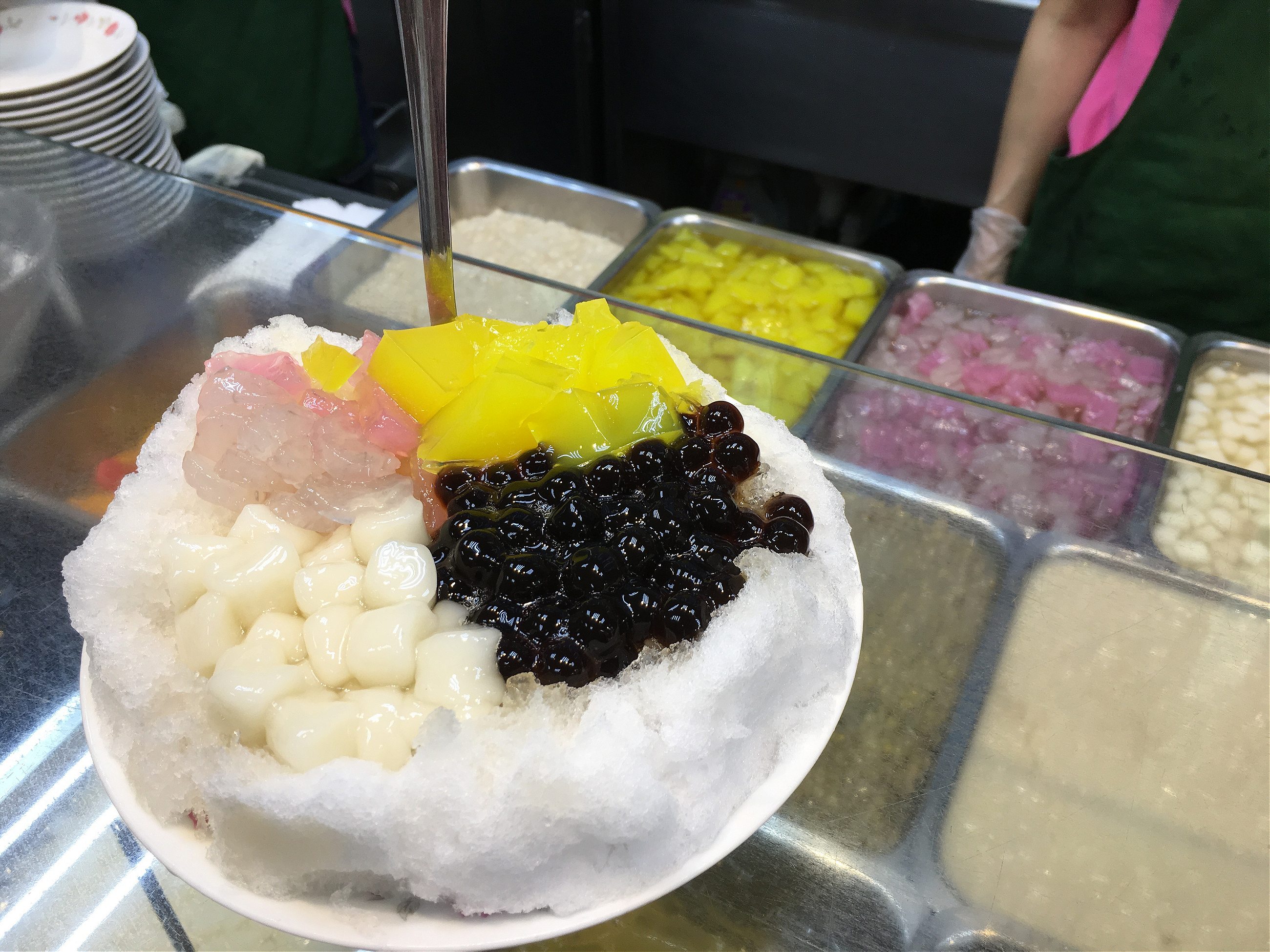
The Q-adorned ice mountain is a stunning panoply of shapes and colors: yellow cubes of fen guo made from sweet-potato flour, pinkish slices of yu yuan (taro), white nubbins of tang yuan (glutinous rice balls), and more familiar black boba pearls of tapioca. The ice starts to melt as I futz around with my camera, trying in vain to capture the image. I dig in. The fen guo and yu yuan look more jelly-like than Q, but looks deceive: jellies dissolve, but these Q-y bits bounce back. The boba pearls slide across the tongue, and tang yuan squish like glorious pillows of mochi, soft and chewy simultaneously. Once again, texture rules the experience. Minus a barely perceptible floral note from a drizzle of fragrant sugar syrup infused with osmanthus blossoms, there’s really no flavor here at all. A bottle of the syrup rests on the counter for those who crave more sweetness, but enthusiastic consumers of Q are just looking for the chew.
Last Bites
Sinewy Q from beef tendon, tender Q from the fish balls, chewy Q from the bawan, and bouncy Q from the tang yuan, Q is not just an obsession with texture over taste, but more of a national comfort food, a mouth feel that finds its way into nearly any meal. Taipei is a humbling—if sometimes daunting—tapestry of eating experiences, and in my attempt to understand its complexities, I realize my quest for Q has just begun. Glaring omissions in my own search for Q abound. Silver needle noodles, sitting at the top of my “must try” list, remains somehow unchecked. And oyster omelets, the night-market find most frequently named “favorite Q” by my Taiwanese friends, somehow hasn’t made the cut. But these will have to wait for another day. Tonight, the kids want fried chicken.